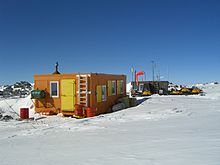Volcano observatory
A volcanic observatory is usually a state institution for the observation and research of active volcanic phenomena. The main tasks include the collection, cataloging and evaluation of observation data ("monitoring" data), the creation of hazard and risk analyzes and maps, advising decision-making bodies ( civil defense , disaster response forces , etc.), public relations work, as well as scientific analyzes and Publications. This catalog of tasks often has different priorities at regional and national level.

Examples of volcanic observatories
The oldest volcano observatory is the Osservatorio Vesuviano in Naples (Italy), founded in 1854 . Historically, catastrophic volcanic eruptions have always played an important role in the establishment of new observatories: the eruption of the Pelé on the Caribbean island of Martinique led to the establishment of the world's second volcanic observatory, the Observatoire Volcanologique de la Montagne Pelée (today's name) by Frank Perret , Albert Brun and Alfred Lacroix , and contributed in a long way to the founding of the “ Hawaiian Volcano Observatory ” by Thomas Jaggar, Jr. - all four volcanologists were among the first highly impressed scientific visitors to the Pelé after the eruption. The eruption of St. Helens volcano in Washington State in 1881 led to the establishment of the Cascades Volcano Observatory (CVO). The three observatories with the most volcanoes in their "patient register" are the " Alaskan Volcano Observatory " (AVO, USA ), the " Southern Andes Volcano Observatory " (OVDAS, Chile ), and the " Seismic Research Unit " (SRU, Trinidad and Tobago , West Indies ). In Iceland , the Meteorological Institute of Iceland is responsible for volcano monitoring in close cooperation with the Geological Institute of the University of Iceland .
Methods of volcano monitoring and observation
Some important instruments for volcano observation are seismographs , tilt meters , GPS , radar interferometry , temperature measurements, gas chemical analyzes, borehole measurements and geological field observation.
In the digital age, volcano observation is sometimes also possible from a distance, both through satellite-based remote sensing and wireless remote data transmission from measuring instruments, as well as through international data exchange (e.g. the GEOWARN project of the European Union ). However, this does not lead to a reduction in costs, but to greater efficiency in the event of a disaster. International efforts are under way to enable a fast and harmonized cross-national exchange of data.
Web links
- World Organization of Volcano Observatories (WOVO)
- International Society of Volcanology and Chemistry of the Earth's Interior (IAVCEI)
- Smithsonian Institution's Global Volcanism Program
- GEOWARN of the EU
- List of links to observatories worldwide
Individual volcano observatories
- USGS Hawaiian Volcano Observatory
- Osservatorio Vesuviano
- Observatoire Volcanologique de la Montagne Pelée
- Iceland Meteorological Institute, IMO
- Institute of Geography Spain: El Hierro series. Monitoring the Hierro , Canary Islands